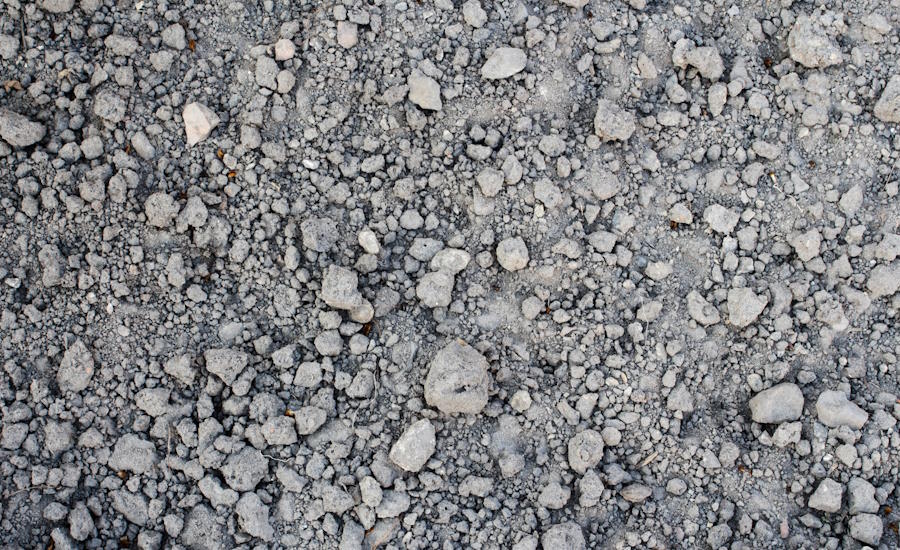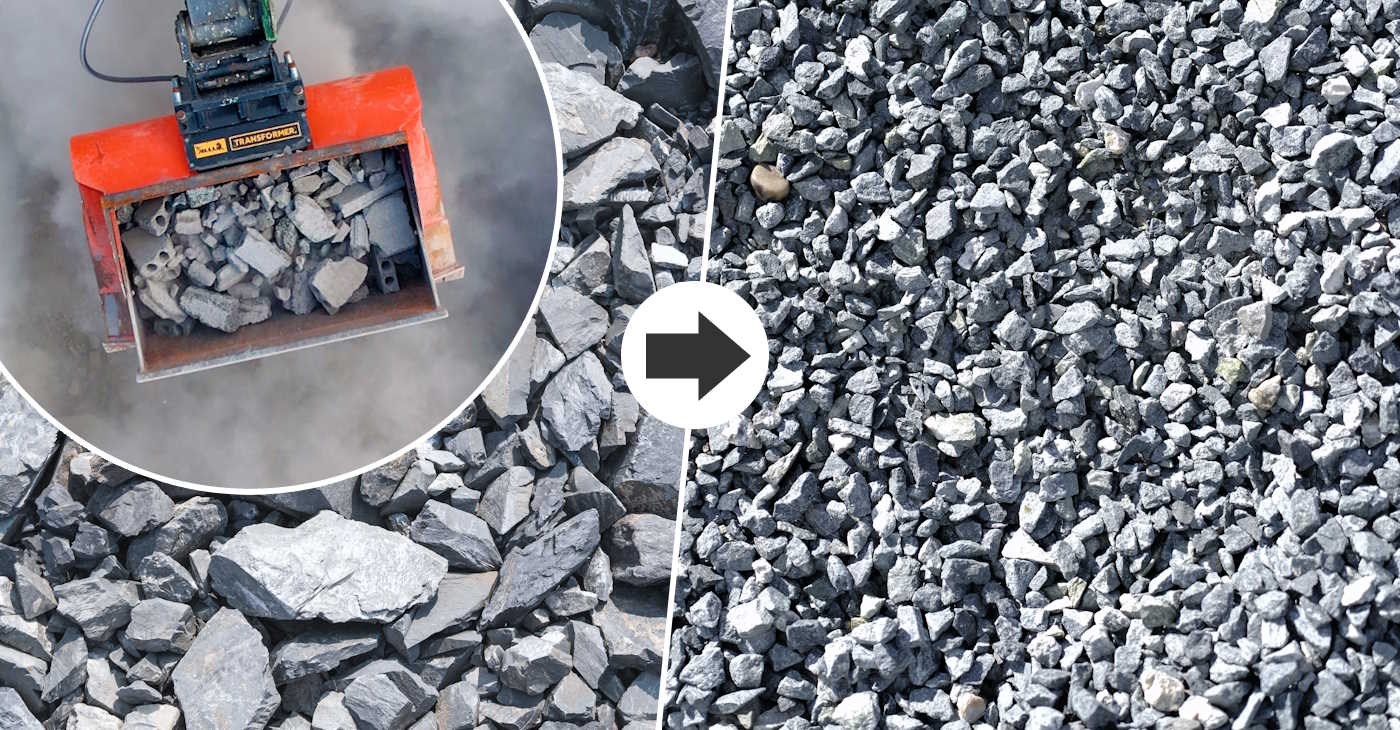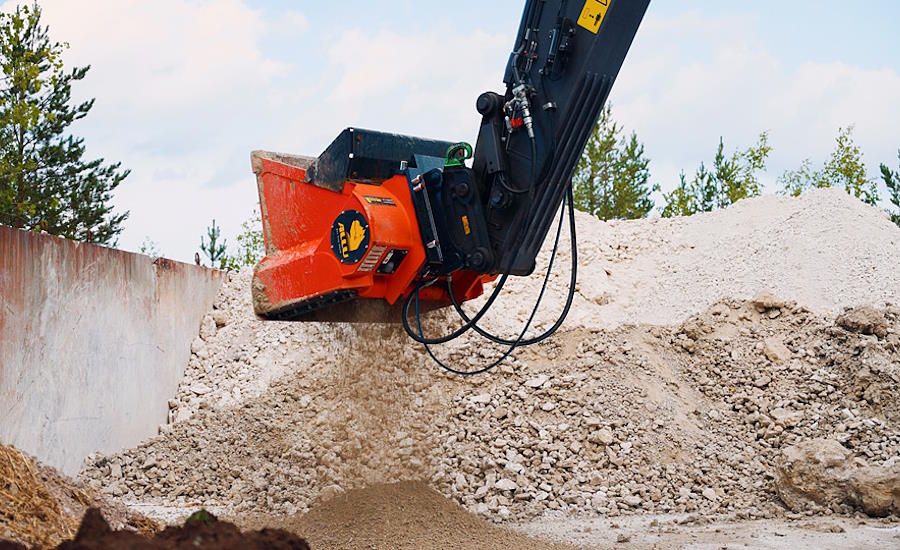Screening buckets, also called rock screening bucket, are the perfect equipment to sort natural materials on site, and they are typically available for a broad range of host machines, including excavators, wheel loaders, and skid-steer loaders. Manufacturers typically offer multiple models to accommodate different carrier sizes, hydraulic flow rates, and application demands. As long as the host machine meets the required hydraulic specifications and has sufficient lifting capacity, a screening bucket can often be fitted with minimal or no major modifications.
What’s a screening bucket?
A screening bucket is an attachment designed to separate and classify materials on-site by using rotating shafts, oscillating rotors, or other mechanical means to sift out oversized fragments. At a fundamental level, it acts as a mobile screen, letting operators sort soil, gravel, rocks, and other aggregates directly at the job location. This eliminates the need to transport unprocessed materials to an off-site facility and then bring them back once sorted.
Screening buckets are often constructed from high-strength, abrasion-resistant steel to withstand constant exposure to harsh materials. They typically have replaceable wear parts, ensuring maintenance can be performed without replacing the entire attachment. These buckets see frequent use in construction, landscaping, demolition, recycling, and agricultural projects where material segregation is crucial.
How they work
While specific internal mechanisms vary by manufacturer and model, most screening buckets rely on a rotating or oscillating screening system:
Material collection
The host machine (excavator, loader, or skid steer) scoops or lifts the raw material into the screening bucket.
Mechanical agitation
Once inside, the bucket’s internal shafts or rotors rotate at a controlled speed. These components are typically fitted with blades, stars, discs, or other elements that break up and agitate the material. This movement forces smaller particles to fall through the apertures (openings) while larger chunks remain inside until they are expelled or dumped.
Particle separation
Depending on the chosen configuration, the bucket’s “screening drums” or shafts have specific spacing to achieve the desired particle size distribution. By selecting different rotor types or adjustable spacers, operators can modify the screening size and achieve a cleaner or coarser end product.
Discharge of oversized material
The oversized material, such as large rocks or debris, remains in the bucket. After processing, the operator can invert or tilt the bucket to dispose of this residue separately.
Thanks to this built-in screening mechanism, there is minimal need for conveyors or external screens. Some advanced models even allow for adjustable speed and direction, providing on-the-fly changes to suit varying material conditions.

Why, and when, do you screen rocks, sand, soil, etc.?
Screening is essential whenever a project demands a specific particle size or composition of the fill material. Common reasons include:
Backfilling
Fine or uniformly graded fill compacts more readily and ensures better structural stability.
Topsoil preparation
Landscaping and agricultural tasks often require stone-free soil to aid with seeding, planting, or turf preparation.
Waste reduction
Separating reusable fill from debris can minimize the volume sent to landfills, leading to cost savings and environmental benefits.
On-Site recycling
When structures are demolished, screening helps reclaim viable aggregates for reuse, reducing the need to purchase and transport new materials.
Drainage and erosion control
Specific grain size distributions are crucial for drainage layers, filtration beds, or erosion control structures.
Typically, screening is performed whenever you want to reduce cost, improve efficiency, or meet strict quality standards for fill or construction aggregates.
Which machines are compatible with a rock screening bucket?
Screening buckets can be mounted on:
Excavators
Ranging from mini-excavators (less than 5 tons) to large hydraulic excavators (30 tons or more), provided they have adequate lift capacity and hydraulic flow.
Wheel loaders
Ideal for bulk material handling and stockpile management; a screening bucket on a wheel loader can scoop large volumes quickly.
Skid-steer loaders
Perfect for smaller-scale or more confined worksites (e.g., urban construction, landscaping). Skid-steer-friendly models are usually more compact and weigh less, yet still effective for moderate sorting tasks.
Each host machine category requires specific couplers or mounting brackets, but the underlying screening function remains largely the same.
The many different purposes!
Screening buckets find application in a broad range of environments:
Construction and earthmoving
Sorting site-won material for backfill, trenching, and foundation works.
Demolition and recycling
Processing demolition debris (e.g., bricks, concrete, asphalt) to isolate usable aggregates.
Landscaping and agriculture
Preparing topsoil, compost, and mulch by removing stones, sticks, and other contaminants.
Industrial and manufacturing sites
Assisting in raw material sorting, particularly for processing plants or storage facilities that need consistent feedstock.
Road and infrastructure projects
Screening base course materials or reclaiming asphalt for re-use.
Mining and quarry operations
Performing preliminary sorting of extracted materials, although dedicated crushing and screening plants may handle final refinement.
Anywhere materials need rapid on-site classification with minimal equipment footprint, a screening bucket can serve as a cost-effective alternative to fixed or more complex screening setups.

Advantages compared to other screening methods
When compared to dedicated stationary or portable screening plants, rock screening buckets offer several distinct advantages:
Mobility and compactness
Screening buckets are easy to transport because they mount directly onto machinery already present on-site, such as an excavator or loader. This reduces the logistical burden of mobilizing and setting up a separate screening plant.
Immediate on-site processing
The operator can scoop, screen, and sort material in a single pass, often eliminating the need for multiple pieces of equipment or repeated handling of raw materials.
Versatility
Many screening buckets handle a variety of materials—from fine topsoil to coarse demolition rubble—by changing the rotor spacing or attachments. This flexibility surpasses certain fixed screens that cater to only one material type or particle size.
Reduced operational costs
By minimizing off-site transport and dumping fees, screening buckets often lead to lower project expenses. Operators can quickly generate backfill material where it is needed, reducing reliance on external suppliers.
Enhanced sustainability
Processing materials on-site can reduce fuel consumption and emissions generated by heavy trucking. In many regions, environmental regulations encourage this form of resource recycling.
Nevertheless, for extremely large-scale or specialized screening (e.g., producing meticulously graded aggregates at high throughput), a dedicated screening plant remains more efficient. Screening buckets shine when agility and simplicity are paramount.
Take part of the advantages you too! Invest in a screening bucket for your excavator and/or wheel loader! Visit ALLU.net and take a look at their ALLU M-serie screening buckets, you’ll not be dissappointed, we promise!
The cost of a rock screening bucket
Prices of a general screening bucket or rock screening bucket varies significantly depending on factors like bucket size, capacity, design complexity, brand reputation, and additional features (e.g., adjustable rotors, special wear-resistant alloys). Smaller models intended for compact excavators or skid steers might start around a few thousand euros (e.g., $5,000 Є – 10,000 Є), while larger, heavy-duty units for full-size excavators could reach tens of thousands of EUR (e.g., 25,000 Є – 50,000 Є +).
Additional considerations include ongoing operational and maintenance costs:
Replaceable wear parts
Rotors, screens, or combs may need periodic replacement depending on usage intensity and the abrasiveness of the material.
Hydraulic requirements
Some models require robust flow rates and may need specialized couplers or lines, adding to installation costs.
Prospective buyers should compare multiple manufacturers and consult detailed specifications to ensure a suitable match between the bucket and the host machine’s capabilities.
Trivia: When were the buckets first invented?
While the concept of material sorting via sifting or screening has existed for centuries, the modern hydraulic-driven screening bucket is commonly attributed to developments in the late 1980s and early 1990s. Several Finnish and Italian manufacturers, according to patent documents and early product catalogs, played a pioneering role in commercializing the first widely adopted screening buckets. Their innovative solutions utilized rotating shafts or trommel-like elements powered directly by the host machine’s hydraulic system.
These early models were revolutionary for on-site screening because they reduced the reliance on static or large-scale screening setups. Although continuously refined over the last few decades—especially with improved rotor designs, wear-resistant materials, and more efficient hydraulic drives—the core functionality remains consistent with the original prototypes. Consequently, screening buckets, while not brand-new, are still perceived by some as cutting-edge, partly due to their rapid market expansion and frequent technological advancements in recent years.
What have we learned about the “rock screening bucket”?
Rock screening buckets represent a powerful synergy between simplicity and technological innovation, enabling construction and earthmoving projects to screen and sort a wide variety of materials on the spot. And yes, these attachments are produced for excavators, loaders, and skid steers, making them accessible to projects ranging from small-scale landscaping all the way to large demolition sites. Their advantages over conventional screening methods are rooted in mobility, reduced operational cost, and flexibility—vital attributes in an industry where efficiency and sustainability continue to grow in importance.
From their initial commercial launch in the early 1990s to today’s advanced, hydraulically optimized versions, screening buckets have demonstrated their enduring value and adaptability. By integrating robust design features with user-friendly adaptability (different rotor sizes, adjustable speeds, and maintenance-friendly parts), these buckets have become indispensable in various fields like road construction, trenching, demolition recycling, and agricultural soil enhancement. Whether you are a seasoned contractor or a newcomer seeking a versatile attachment for your machinery, a screening bucket can be a pivotal addition to your equipment arsenal—one that streamlines material handling, lowers transportation costs, and ultimately contributes to a more sustainable, self-reliant job site.
Our next article here at Infrastructural.net follows a bit in the same area, and is about “Land Clearing and Excavation“, you don’t wanna miss this!


